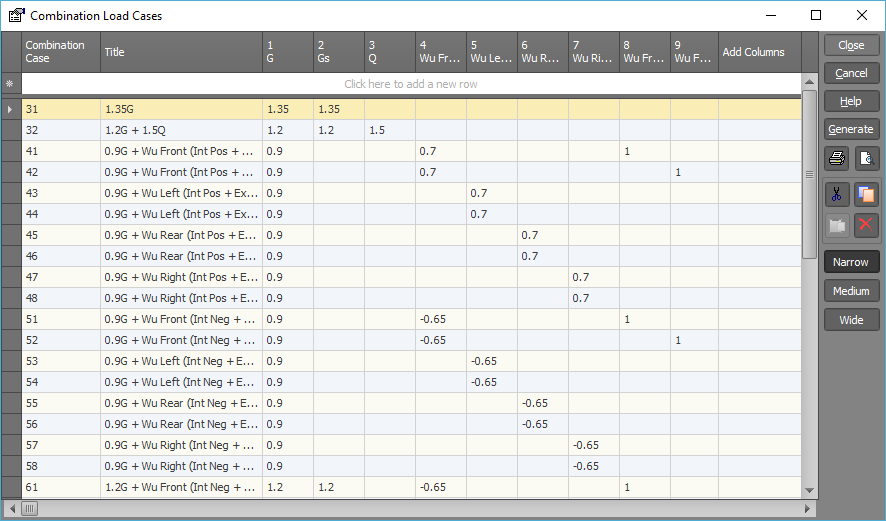Combination load case data

All loads applied to a structure are always input via primary load cases. Further load cases can be created by combining the various primary load cases into combination load cases.
![]() Combination load cases can be combined into further
combination load cases.
Combination load cases can be combined into further
combination load cases.
Combination case
Load case to be formed. Cannot be equal to a primary load case.
Case
Load case to be factored and combined into the combination. This can be a primary load case or a combination load case.
Multiplying factor
The multiplying factor applied to the primary load case when it is combined.
Consider for example a structure that is to be analysed for the following combination load cases 10, 11 and 12.
|
Load case 1: |
Self weight (SW) |
|
Load case 2: |
Floor load (LL1) |
|
Load case 3: |
Roof traffic (LL2) |
|
Load case 4: |
Cladding (CL) |
|
Load case 5: |
Wind load (WL) |
|
Load case 20: |
1.25*DL + 1.50*LL |
|
Load case 21: |
0.80*DL + 1.50*LL |
|
Load case 22: |
0.80*DL + 1.00*WL, |
|
where |
DL = SW + CL |
|
|
LL = LL1 + LL2 |
The desired combination load cases could then be made up as follows.
|
Load case 10 (DL): |
1.00*Load case 1 + 1.00*Load case 4 |
|
Load case 11 (LL): |
1.00*Load case 2 + 1.00*Load case 3 |
|
Load case 20: |
1.25*Load case 10 + 1.50*Load case 11 |
|
Load case 21: |
0.80*Load case 10 + 1.50*Load case 11 |
|
Load case 22: |
0.80*Load case 10 + 1.00*Load case 5 |
Note that for a linear analysis, it is not necessary to analyse the combination load cases. They can be calculated by simple linear superposition of the primary load case results during the output phase. For a non-linear (2nd order) analysis however, the simple linear superposition rules don’t apply and combination load cases have to be fully analysed and treated in the same way as primary load cases.
For this reason, SPACE GASS allows you to decide whether or not to analyse the combination load cases and treat them the same as primary load cases or to not analyse them and have them calculated by simple linear superposition during the output phase. You can specify the load cases that you want analysed by listing them at the start of the analysis phase. For example, if you have primary load cases 1,2,3 and 4, and combination load cases 10,11 and 12, you could analyse just the primaries by entering 1-4 for the load cases list.
If you have a combination load case that combines static load cases with result load cases from a harmonic or transient response analysis then you must carefully check that the harmonic or transient result load cases exist before you use the results of the combination. If the harmonic/transient result load cases have been deleted (due to a change in the model, a load change, a mass change, a dynamic frequency re-analysis, a harmonic response re-analysis or a transient response re-analysis) then the combination will just contain the results of the static load cases. Because SPACE GASS allows combination load cases to include non-existent load cases, it doesn't give any warnings or errors if the harmonic or transient result load cases are missing. It can't even detect that they are missing because they have no input data associated with them. One way for you to quickly check if combination load cases contain harmonic or transient analysis results is to look for "harmonic" or "transient" in the load case heading in analysis result reports (eg. "Load case 301 (LinComb+Harmonic)" or "Load case 301 (LinComb+Transient)" or "Load case 302 (Harmonic)" or "Load case 302 (Transient)").
![]() If you are doing a spectral response analysis, you should create a reverse combination load
case for each spectral load case. You may also have to create further combinations to combine the spectral load cases with different direction vectors. For more information refer to Spectral load data.
If you are doing a spectral response analysis, you should create a reverse combination load
case for each spectral load case. You may also have to create further combinations to combine the spectral load cases with different direction vectors. For more information refer to Spectral load data.
![]() SPACE GASS allows combination load cases to include non-existent load cases without issuing
any warnings or errors.
SPACE GASS allows combination load cases to include non-existent load cases without issuing
any warnings or errors.
![]() SPACE GASS will not allow a combination load case to be a simple linear combination of analysed
primary load cases if any of the primaries have been analysed non-linearly or if the frame contains tension-only or compression-only members. In this case the combination load case must be analysed.
SPACE GASS will not allow a combination load case to be a simple linear combination of analysed
primary load cases if any of the primaries have been analysed non-linearly or if the frame contains tension-only or compression-only members. In this case the combination load case must be analysed.
![]() You can modify the combination load case data and obtain new results without re-analysing the structure,
however this only applies to linear superposition combinations. Results for analysed combinations are deleted if the combination load case data is changed.
You can modify the combination load case data and obtain new results without re-analysing the structure,
however this only applies to linear superposition combinations. Results for analysed combinations are deleted if the combination load case data is changed.
See also Combination load cases text.
See also Datasheet Input.
See also Combination load cases.